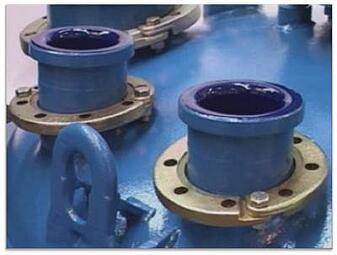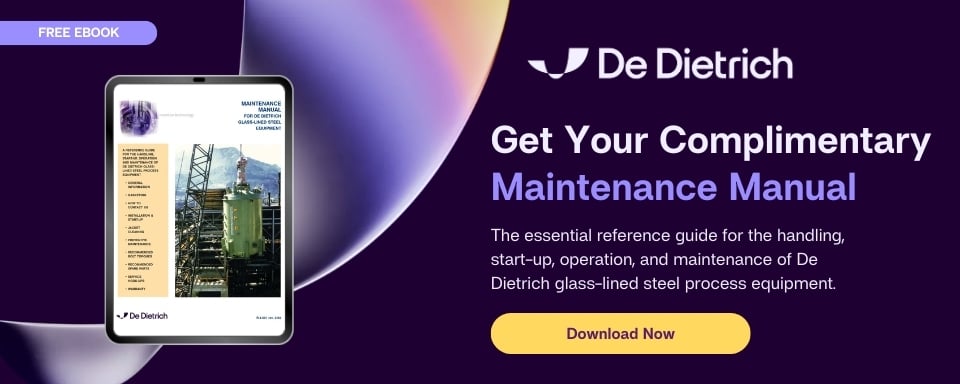Best Practices for Avoiding Damage in Glass-Lined Equipment (Part 1)
 It’s no secret that while glass-lined equipment has its fair share of advantages, making it a superior material of construction for many processes, it also requires a little extra TLC due to the unique properties associated with glass lining. But did you know that most damage caused in glass-lined equipment is preventable? Through instructional training, adhering to operational guidelines, and following a disciplined maintenance routine, you can ensure that your equipment maintains its integrity and performance.
It’s no secret that while glass-lined equipment has its fair share of advantages, making it a superior material of construction for many processes, it also requires a little extra TLC due to the unique properties associated with glass lining. But did you know that most damage caused in glass-lined equipment is preventable? Through instructional training, adhering to operational guidelines, and following a disciplined maintenance routine, you can ensure that your equipment maintains its integrity and performance.
There are four main categories of failure modes that can occur in glass-lined equipment: mechanical, thermal, electrical, and chemical. These issues, however, can be eliminated or drastically reduced through the identification of the various types of glass failure and by asserting the best practices to avoid them.
The following information has been extracted from Materials Technology Institute's Repair and Damage Assessment for Glass-Lined Equipment, written by Sal Falcone and Bert Moniz. (More information about this book can be found on MTI’s website) These important points serve as an excellent resource for plant managers, maintenance engineers, and any other personnel who works in close contact with glass-lined equipment and systems. In this first of two posts, we’ll discuss the best practices for preventing mechanical and thermal damage.
Mechanical Impact
Internal Impact
Bad practice: Allowing a hard object heavier than 1 pound to fall from greater than 9 inches can cause glass damage.
Good practices:
- Padding the floor and agitator blades when working inside equipment.
- All covering open manways and nozzles during maintenance work when not in use.
External Impact
Bad practice: Allowing workers to strike the outside of glass-lined vessel, leading to internal damage
Good practices:
- Training people not to be “bell ringers” near glass-lined equipment!
- Avoiding glass-lined vessels brushing or striking anything during rigging.
- Ensuring glass-lined equipment is clearly labeled.
Hydroblasting
Bad Practice: Impinging water pressures at greater than 2000 psi at a hose nozzle distance less than 12 in., which may cause glass damage.
Good practices:
- Using a filter to remove particulate matter from the water.
- Moving the water lance continuously to minimize focusing the jet in one spot.
- Protecting the manway from accidental lance contact by means of a PTFE liner.
- Avoiding water jet contact with repair areas such as plugs and patches.
Abrasion
Bad Practice: Allowing glass contact by solids harder than glass, which will cause general abrasion or local scratching.
Good practices:
- Evaluating slurries for their abrasive effect before use.
- Following strict housekeeping rules when entering and working inside glass-lined vessels
Cavitation
Bad practice: Collapsing bubble locally generate impact forces on glass surfaces
Good practices:
- If cavitation can be heard (usually a buzzing sound), adjust sparging and reduce agitator speed until the sound disappears.
- Avoiding low boiling point compounds of process fluids to be in solution.
- Operating at higher pressure.
- Using sparkers with small holes directed away from vessel sidewalls
- For condensable vapor additions, incorporating a small amount of noncondensible vapor such as nitrogen to prevent bubble collapse.
Mechanical Stress
Crushing
Bad Practice: Allowing glass to be crushed under excessive local compression
Good practices:
- Avoiding the practice of prying against a glass surface with a screw driver or other device.
- Using a flange spreader to separate flanges.
- Applying zero bending load on nozzles by supporting connected piping.
- Supporting excessive hanging weight on the bottom outlet nozzle.
- Using an approved line blinding method.
- Using approved gaskets and torque procedure.
Bending
Bad practice: Allowing glass-lined nozzles to experience bending moments greater than 100 ft-lb per inch of nozzle diameter may cause cracks in the glass.
Good practices:
- Ensuring piping connected to glass vessels does not result in stresses and moments on the nozzle by using stress analysis and proper alignment.
- Supporting piping and components attached to all nozzles.
- Having a short section of piping connected directly to the vessel flange, breaking the line one flange away from the Bessel first of all, and connecting the short pipe to the vessel first when reinstalling.
- Adequate saddle supports when storing, transporting, or operating horizontal vessels.
Vibration
Bad Practice: Operating conditions that result in excessive vibrations are not eliminated and result in failure of internal steel members by fatigue.
Good Practices:
- Positioning h, d, beavertail (wide eye), finger and fin baffles radially in line with agitator shaft
- Ensuring appropriate agitation for the reaction based on stress analysis and mixing requirements.
- Sizing dip tubes for process conditions.
- Locating dip tubes behind a baffle in the direction of flow.
- Designing dip tubes to be shorter than the length of nearby baffles.
- Using dip tubes for their proper purpose, not as baffles.
- Using proper sparging design when injecting steam or hot gases.
Thermal Shock
General Thermal Shock
Bad practices:
- Making cold liquid addition onto hot glass surfaces (worst case)
- Making hot liquid addition on cold glass surfaces.
- Allowing rapid endothermic or exothermic process reactions.
Good practices:
- Making sure sudden temperature changes are less than T260F as conservative rule, or using the glass manufacturers’ charts to define an appropriate value.
- Using a dip tube for additives that exceed thermal shock limits.
- In critical applications, using a fast resistance-type temperature probe to gain data on temperature change.
- Programming or controlling steam addition in jacket.
- Ensuring glass thickness at convex surfaces (e.g. nozzles) does not exceed maximum requirements.
Local Thermal Shock
Bad Practices:
- Allowing hot or cold fluid to impinge on the shell (e.g., steam at jacket nozzle inlet).
- Adding steam through a sparger that allows it to impinge on the opposite wall of vessel
- Adding hot or cold fluid directly through a nozzle, allowing it to run down the wall.
Good practices:
- Checking jacket nozzle to ensure that the impingement baffle (deflector plate) and agitation nozzle are intact and not corroded.
- Preventing blow back (impingement from reverse flow) by means of a functioning check valve.
- Installing a vacuum breaker at the upper jacket nozzle to prevent introduction of cold water in a hot jacket
- Programming or controlling steam addition to allow gradual thermal equilibrium
- Designing the sparger to avoid direct steam impingement on glass surface.
- Always adding fluids through a dip tube or nozzle liner.
- Ensuring that absence of complete insulation does not create a local thermal shock problem.
Welding Near Glass
Bad Practice: Welding on metal near glass causes glass to shatter because of the significant rate of temperature change.
Good Practices:
- Welding less than a four-inch long bead in any area at one time
- Allowing glass in weld areas to cool enough to be comfortable to the touch between applications of weld bead.
- Keeping air flowing in a jacket to increase cooling effect.
- Developing a repair welding procedure and qualifying welders to the procedure
- Avoiding weld spatter on glass by covering it with a blanket.
Thermal Stress
Restricted flexibility from large fillet welds
Bad Practices:
- Causing temperature differentials across large fillet welds that exist between jacketed and non-jacketed locations to transmit high stress to a glass lining.
- Allowing plugging of the outlet nozzle jacket diaphragm ring, which causes it to be excessively stiff, reduces its capability to move in response to thermal stresses.
Good practices:
- Conducting a thermal stress analysis if high thermal stresses are suspected.
- Blowing down sludge regularly to avoid plugging of outlet nozzle diaphragm ring.
Expansion of Steel
Bad Practice: Avoiding excessive steel expansion, which causes glass to spall.
Good practices:
- Preventing water from freezing in baffles or jacket (e.g. outdoor storage)
- If jacket fluid is not circulating, draining the fluid completely and venting the jacket
- For steam-jacketed units, slightly opening the blowdown valve on the strainer upstream from the trap to prevent condensate from flooding the jacket and freezing if the steam trap fails.
- Operating within temperature and pressure rating of vessel jacket.
- Venting liquid-filled thermocouple baffles to avoid pressure buildup during reaction heat-up.
Stay tuned for next week’s post where we’ll pick up where we left off and discuss best practices for preventing electrical damage and chemical attacks on glass-lined equipment.

